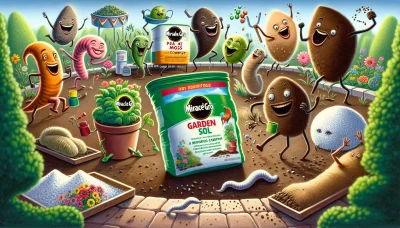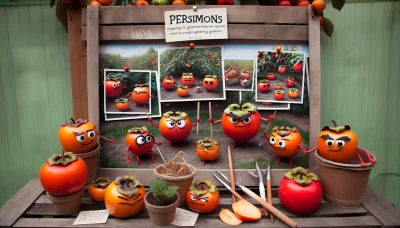Persimmon pulp Quiz
Test Your Knowledge
Question of
The Wonders of Persimmon Pulp
Persimmon pulp, derived from the soft, ripe fruit of the persimmon tree, is a highly valued commodity in both culinary and gardening circles. This rich, sweet substance not only serves as a key ingredient in various recipes, ranging from puddings to breads, but also plays a significant role in gardening. In the realm of gardening, persimmon pulp is celebrated for its nutrient-rich composition, which can significantly enhance soil quality. When incorporated into garden soil, the pulp acts as a natural fertilizer, providing essential nutrients that support plant growth and soil health. Its use in gardening underscores a sustainable approach to cultivation, where natural by-products are recycled to nourish the earth, thereby fostering a more productive and environmentally friendly gardening practice.
Types of Persimmons for Pulp
- Hachiya: This is a popular astringent variety of persimmon that is best used for pulp when fully ripe. It has a heart shape and is known for its rich flavor.
- Fuyu: Fuyu persimmons are non-astringent and can be eaten raw or used for pulp. They have a squat shape and a sweet, mild taste that makes them versatile for various culinary uses.
- Tanenashi: Tanenashi persimmons are cone-shaped and astringent. They are highly valued for their smooth texture and sweet taste once they are fully ripe and soft.
- Chocolate: Named for its brown-fleshed fruit, the Chocolate persimmon is astringent and offers a unique, rich flavor that adds depth to pulp and other dishes.
- Maru: Also known as the "cinnamon persimmon" for its spicy undertones, Maru is a smaller, round, astringent variety that becomes incredibly sweet and flavorful when ripe.
- Giombo: This astringent, large fruit has a slightly elongated shape and is known for its juicy, sweet taste, making it perfect for creating a smooth, flavorful pulp.
How to Harvest and Prepare Persimmon Pulp
Harvesting persimmons and preparing the pulp is a rewarding process that allows you to enjoy the sweet, unique flavor of this fruit in various recipes. The key to a successful harvest is to wait until the fruit is fully ripe, which is typically indicated by a deep orange color and a soft texture. Once harvested, the pulp can be extracted and used immediately or stored for future use. The process involves selecting the right fruit, extracting the pulp, and preparing it for your recipes.
- Wait for the persimmons to fully ripen on the tree; they should be soft to the touch and a deep orange color.
- Gently pick the ripe persimmons to avoid bruising them.
- Wash the persimmons thoroughly under running water to remove any dirt or debris.
- Cut off the top leafy part of the persimmon and slice the fruit in half.
- Use a spoon to scoop out the pulp from the skin, discarding any seeds you encounter.
- For a smoother pulp, pass the scooped pulp through a sieve or food mill to remove any remaining skin pieces or seeds.
- The prepared pulp can now be used immediately in your recipes or stored in the refrigerator for up to three days or frozen for longer storage.
Benefits of Persimmon Pulp in the Garden
Persimmon pulp, often overlooked, is a fantastic addition to any garden due to its rich nutritional profile that can significantly benefit plant growth. This natural by-product is packed with essential nutrients that plants crave, including vitamins, minerals, and antioxidants. Adding persimmon pulp to your garden can help improve soil fertility by enhancing its organic matter content, which in turn, supports better water retention and provides a healthier environment for beneficial microorganisms. Its high potassium content is particularly beneficial for flowering and fruiting plants, helping them produce more vibrant and healthier blooms and fruits. Moreover, the natural sugars in the pulp can attract beneficial insects, promoting pollination and natural pest control. Utilizing persimmon pulp in gardening not only recycles what would otherwise be waste but also contributes to a more sustainable and productive garden ecosystem.
Creative Uses for Persimmon Pulp
Persimmon pulp is often celebrated for its role in gardening, but its versatility extends far beyond enriching soil. This vibrant, sweet fruit pulp can be transformed into a myriad of delightful and unexpected products, offering a unique twist to traditional recipes and crafts. From culinary adventures to homemade beauty treatments, the potential uses for persimmon pulp are boundless. Explore the following list to discover innovative ways to incorporate this seasonal delight into your daily life.
- Baking Persimmon Bread or Muffins
- Creating Persimmon Jam or Jelly
- Making Persimmon Sorbet or Ice Cream
- Preparing Homemade Persimmon Face Masks
- Crafting Persimmon Pulp Candles
- Developing Persimmon Flavored Sauces or Dressings
- Blending Persimmon Smoothies or Cocktails
- Producing Persimmon Leather or Dried Snacks
- Incorporating Persimmon Pulp into Oatmeal or Yogurt
- Using Persimmon Pulp as a Natural Fabric Dye
Storing and Preserving Persimmon Pulp
To ensure the longevity and freshness of persimmon pulp, proper storage and preservation techniques must be followed. Persimmon pulp can be stored in the refrigerator or freezer, depending on how soon you plan to use it. Refrigeration is suitable for short-term storage, while freezing can extend the pulp's shelf life significantly. It's important to store the pulp in airtight containers or heavy-duty freezer bags to prevent freezer burn and oxidation. Additionally, labeling the containers with the date of storage can help keep track of freshness and ensure the pulp is used within its optimal period.
| Storage Method | Shelf Life | Tips for Preservation |
|---|---|---|
| Refrigeration | 3-5 days | Use airtight containers, keep at consistent temperature |
| Freezing | Up to 12 months | Use heavy-duty freezer bags or airtight containers, remove as much air as possible |












